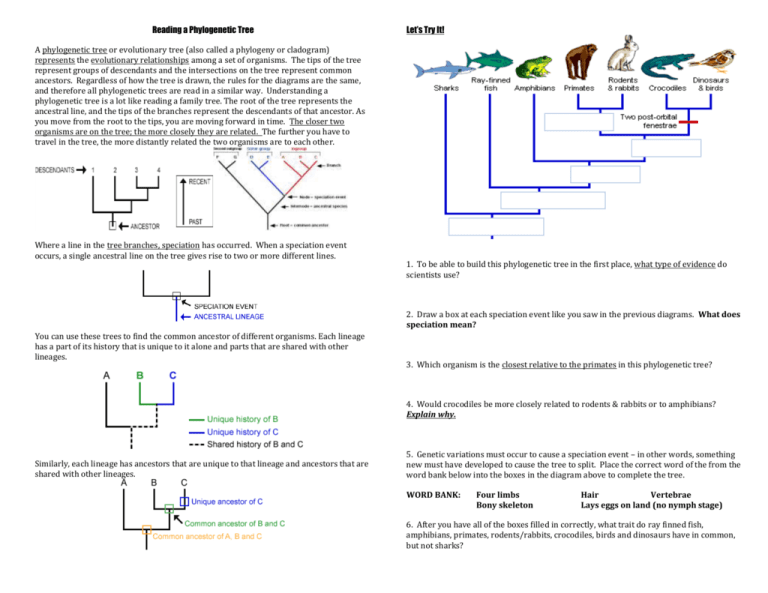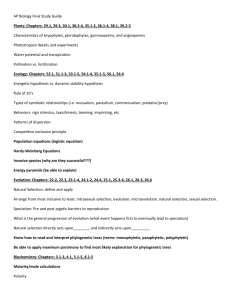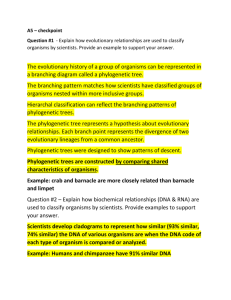Reading a Phylogenetic Tree_reduced size
advertisement

Reading a Phylogenetic Tree Let’s Try It! A phylogenetic tree or evolutionary tree (also called a phylogeny or cladogram) represents the evolutionary relationships among a set of organisms. The tips of the tree represent groups of descendants and the intersections on the tree represent common ancestors. Regardless of how the tree is drawn, the rules for the diagrams are the same, and therefore all phylogenetic trees are read in a similar way. Understanding a phylogenetic tree is a lot like reading a family tree. The root of the tree represents the ancestral line, and the tips of the branches represent the descendants of that ancestor. As you move from the root to the tips, you are moving forward in time. The closer two organisms are on the tree; the more closely they are related. The further you have to travel in the tree, the more distantly related the two organisms are to each other. Where a line in the tree branches, speciation has occurred. When a speciation event occurs, a single ancestral line on the tree gives rise to two or more different lines. 1. To be able to build this phylogenetic tree in the first place, what type of evidence do scientists use? 2. Draw a box at each speciation event like you saw in the previous diagrams. What does speciation mean? You can use these trees to find the common ancestor of different organisms. Each lineage has a part of its history that is unique to it alone and parts that are shared with other lineages. 3. Which organism is the closest relative to the primates in this phylogenetic tree? 4. Would crocodiles be more closely related to rodents & rabbits or to amphibians? Explain why. Similarly, each lineage has ancestors that are unique to that lineage and ancestors that are shared with other lineages. 5. Genetic variations must occur to cause a speciation event – in other words, something new must have developed to cause the tree to split. Place the correct word of the from the word bank below into the boxes in the diagram above to complete the tree. WORD BANK: Four limbs Bony skeleton Hair Vertebrae Lays eggs on land (no nymph stage) 6. After you have all of the boxes filled in correctly, what trait do ray finned fish, amphibians, primates, rodents/rabbits, crocodiles, birds and dinosaurs have in common, but not sharks? Reading a Phylogenetic Tree Let’s Try It! A phylogenetic tree or evolutionary tree (also called a phylogeny or cladogram) represents the evolutionary relationships among a set of organisms. The tips of the tree represent groups of descendants and the intersections on the tree represent common ancestors. Regardless of how the tree is drawn, the rules for the diagrams are the same, and therefore all phylogenetic trees are read in a similar way. Understanding a phylogenetic tree is a lot like reading a family tree. The root of the tree represents the ancestral line, and the tips of the branches represent the descendants of that ancestor. As you move from the root to the tips, you are moving forward in time. The closer two organisms are on the tree; the more closely they are related. The further you have to travel in the tree, the more distantly related the two organisms are to each other. Where a line in the tree branches, speciation has occurred. When a speciation event occurs, a single ancestral line on the tree gives rise to two or more different lines. 1. To be able to build this phylogenetic tree in the first place, what type of evidence do scientists use? 2. Draw a box at each speciation event like you saw in the previous diagrams. What does speciation mean? You can use these trees to find the common ancestor of different organisms. Each lineage has a part of its history that is unique to it alone and parts that are shared with other lineages. 3. Which organism is the closest relative to the primates in this phylogenetic tree? 4. Would crocodiles be more closely related to rodents & rabbits or to amphibians? Explain why. Similarly, each lineage has ancestors that are unique to that lineage and ancestors that are shared with other lineages. 5. Genetic variations must occur to cause a speciation event – in other words, something new must have developed to cause the tree to split. Place the correct word of the from the word bank below into the boxes in the diagram above to complete the tree. WORD BANK: Four limbs Bony skeleton Hair Vertebrae Lays eggs on land (no nymph stage) 6. After you have all of the boxes filled in correctly, what trait do ray finned fish, amphibians, primates, rodents/rabbits, crocodiles, birds and dinosaurs have in common, but not sharks?








